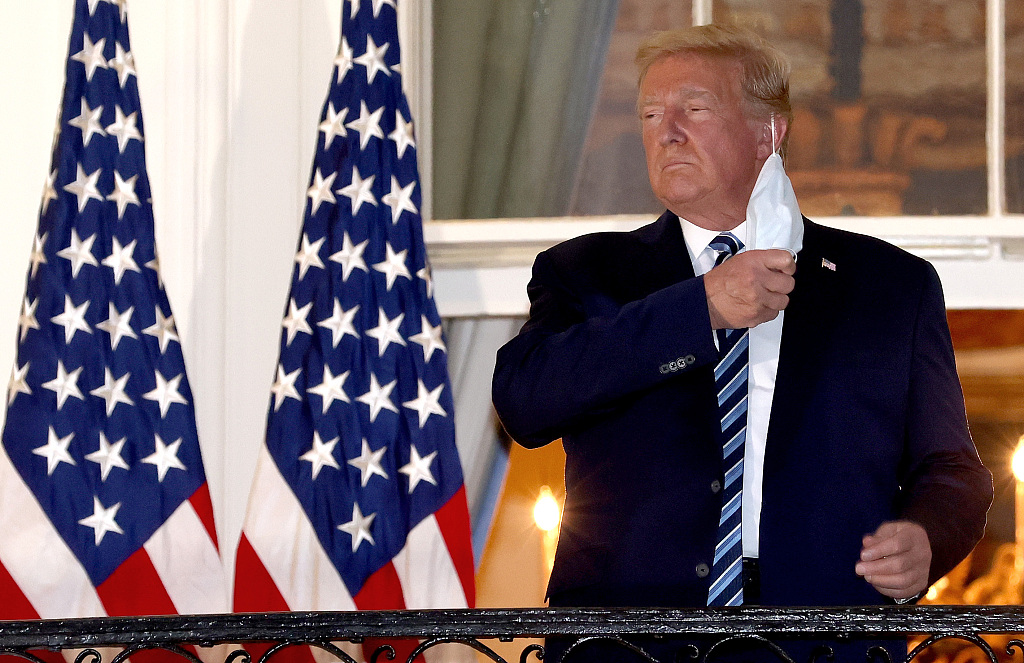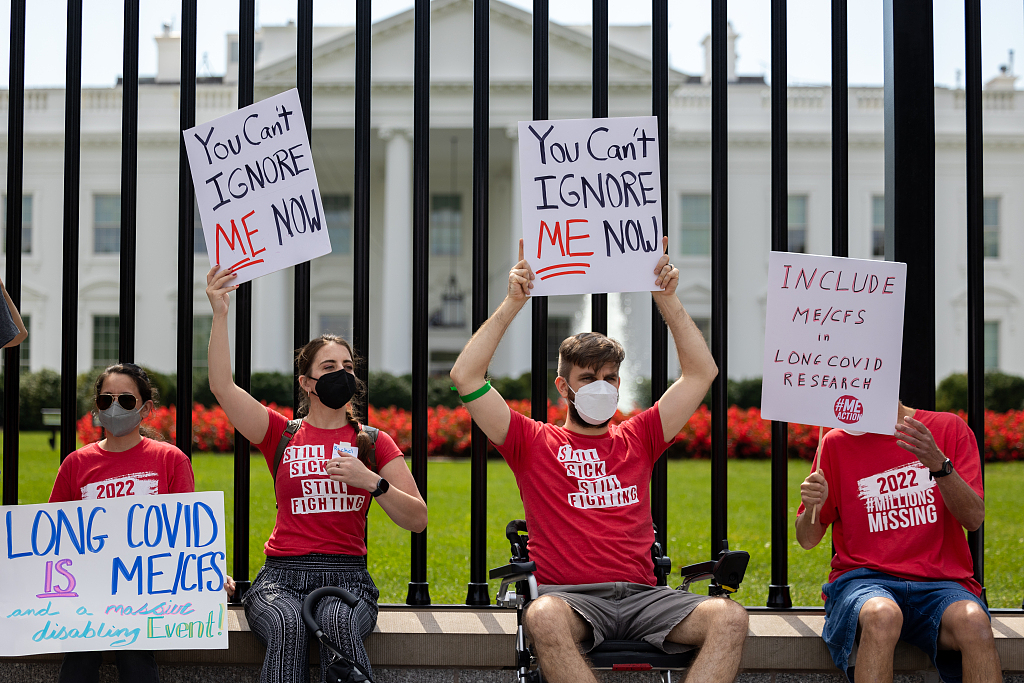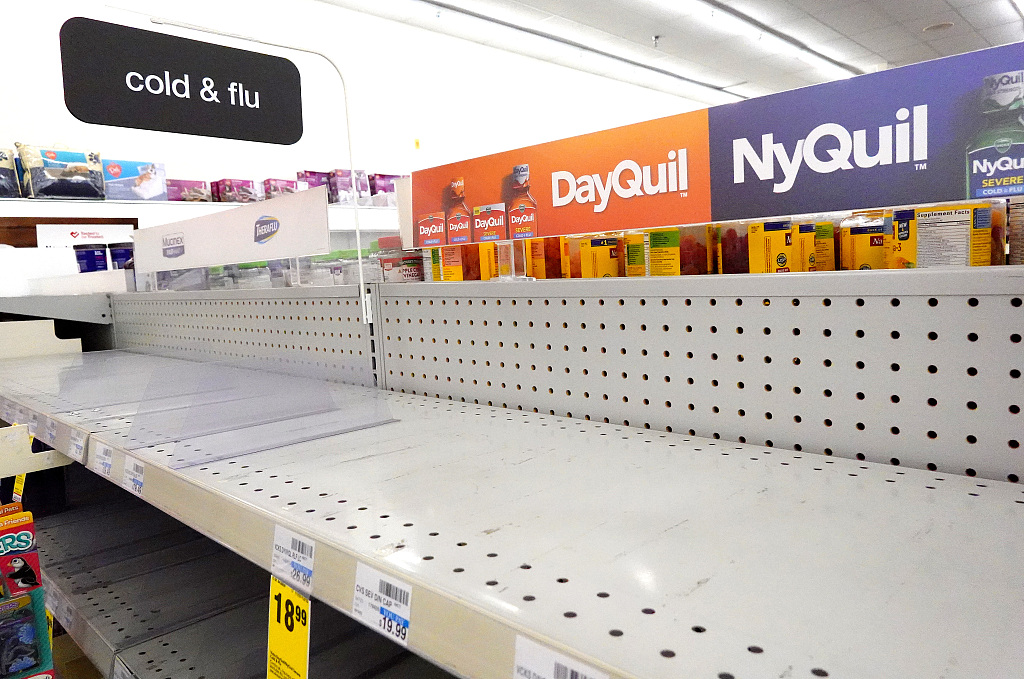Editor's note: CGTN's First Voice provides instant commentary on breaking stories. The column clarifies emerging issues and better defines the news agenda, offering a Chinese perspective on the latest global events.
On December 20, the United States reached a morbid milestone: 100 million Americans have been infected by SARS-COV-2. More than 1.08 million Americans have died from it.
The United States is recognized as one of the richest countries in the world with the world's best and most advanced medical capabilities. How did a well-prepared country become a modern epidemiological cautionary tale?
Do you still remember this picture?

Former U.S. President Donald Trump removing his mask at the White House on October 5, 2022 after returning from a three-day stay at the Walter Reed Medical Center for COVID-19. /CFP
Former U.S. President Donald Trump removing his mask at the White House on October 5, 2022 after returning from a three-day stay at the Walter Reed Medical Center for COVID-19. /CFP
When former U.S. President Donald Trump took off his mask on the White House's South Portico in front of the global press, the United States was already in the thrall of the coronavirus. More than 200,000 Americans had died.
Yet, that moment epitomizes America's response to the pandemic. By making that performance, he solidified pandemic response's central role in political battles. On the one hand, those who supported Trump's actions blasted his opponents for cratering the country's economy and restraining people's freedom; On the other, those who wanted Trump out of the office blamed him for the hundreds of thousands of deaths and used it as a proof of Trump's incompetence in governance. The biological virus became a political one and fueled the American political discourse.
Actions of a similar caliber would later be repeated by President Joe Biden, whom, during the midterm elections, declared that the COVID-19 pandemic was over while on average about 400 Americans have died due to the pandemic every day. When asked about it in an interview with 60 Minutes, Biden said, "if you notice, no one's wearing masks. Everybody seems to be in pretty good shape. And so I think it's changing." Even though, his administration was still asking Congress for pandemic-related funding and campaigning to get people to take booster shots.

Protestors chant outside the White House to call attention to those suffering from Myalgic Encephalomyelitis and long-COVID in Washington, D.C., September 19th, 2022. CFP
Protestors chant outside the White House to call attention to those suffering from Myalgic Encephalomyelitis and long-COVID in Washington, D.C., September 19th, 2022. CFP
Politicization is the virus's force-multiplier. It divides the populace along an ideological instead of scientific line, getting a substantial portion of the country to behave in a way that the others wouldn't. It distracts people's attentions away from combating the pandemic, making pandemic response a partisan talking point instead of rigorous scientific protocols. Thus, providing the virus enough room to flourish and spread unchecked. Even the world’s best medical capabilities can’t stand assaults from within.
In today's world, politicization and distraction lead to the reduction in people's focus on the pandemic is damaging. As countries around the world try to find their own way to opening-up and normalize cross-border engagements while having to face the fallout of the Ukraine conflict, the surging energy crisis, food security crisis and the prospect of economic recessions in many major economies, it is all the more important to sound the alarm again over how the pandemic still poses a grave threat to global public health.
The response to the COVID-19 pandemic has been uneven across the globe. The responses are conditioned by the existing public health infrastructure, economic prowess and international aid. An article published by Nature found that, early in the pandemic before vaccines were rolled out, the risk of dying from COVID-19 was nearly twice as high for people in low- and middle-income countries as those in rich countries.

A cold and flu medicine shelf is empty in a CVS pharmacy in Burbank, California, December 6, 2022. Southern California is being hit by a wave of three viruses, the flu, COVID-19 and RSV, with the CDC classifying the state of California as having a "high" level of flu activity. /CFP
A cold and flu medicine shelf is empty in a CVS pharmacy in Burbank, California, December 6, 2022. Southern California is being hit by a wave of three viruses, the flu, COVID-19 and RSV, with the CDC classifying the state of California as having a "high" level of flu activity. /CFP
The UNDP's data shows that, as of November 30, 2022, 72.8 percent of people in high-income countries have been vaccinated with at least one dose of COVID-19 vaccine. In low-income countries, only 28.31 percent of the population have. High-income countries only have to increase their health care spending by 0.8 percent on average to cover the cost of vaccinating 70 percent of the population. Low-income countries have to increase it by 56.5 percent.
Perhaps, the American politicians and many ordinary Americans could accept the 100 million infections. Nonetheless, those that are less capable have to pay a greater price to protect their people. And the challenges they are confronting are compounded by the diminished global attention over the pandemic and the rivalries that are ongoing between major powers.
The COVID-19 pandemic has not ended. The 100 million infections in the United States are a stark reminder to the world of that fact. Letting our guard down would only set the virus free, allowing it to continue wreak havoc that the world has spent three years to recover.
(If you want to contribute and have specific expertise, please contact us at opinions@cgtn.com. Follow @thouse_opinions on Twitter to discover the latest commentaries in the CGTN Opinion Section.)